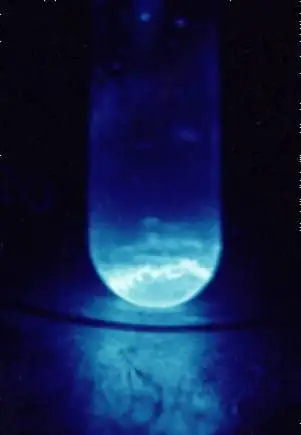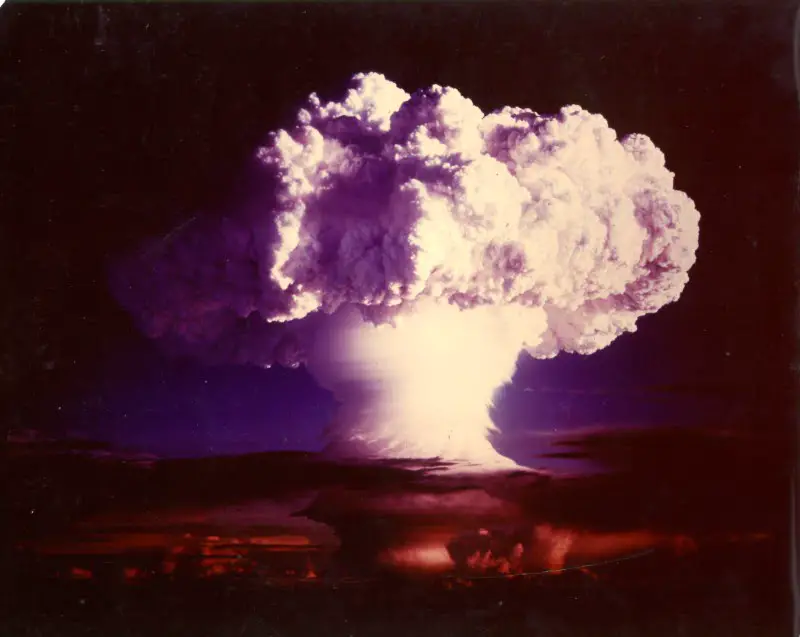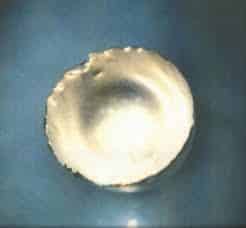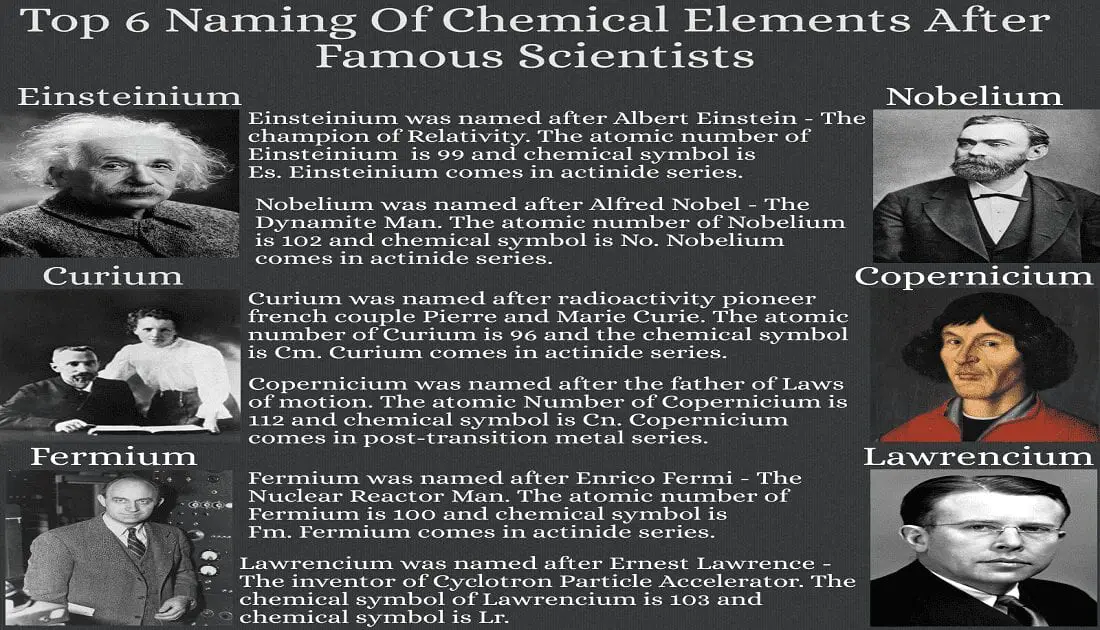Wanna know what are the elements named after scientists? FAMOUS ONES…!!! If yes, then look no further. As of today, 118 elements and their symbols have been discovered and placed accordingly in the periodic table of elements. A periodic table of elements with names and symbols is decided by the International Union Of Pure And Applied Chemistry (IUPAC).
On the other hand, the naming of chemical elements are being decided upon by a couple of factors like the color or properties of the elements, the place it was discovered, or by whom it was discovered.
Top 6 Elements Named after Famous Scientists
If you think you can’t relate to any element named after a famous scientist, well, here is your chance to think again…!!!
- Einsteinium
- Nobelium
- Curium
- Copernicium
- Fermium
- Lawrencium
Einsteinium

This transuranic element was first discovered as a by-product of the debris of the first Hydrogen Bomb Explosion in 1952 in the United States of America (USA). Though this element was discovered by American nuclear scientist Albert Ghiorso and his co-worker at the University of California.
However, in order to honor the greatest scientist of the 20th century Albert Einstein, this synthetic element bears the name Einsteinium. The atomic number of Einsteinium is 99 and its chemical symbol is Es. In periodic table groups, Einsteinium comes in actinide series.
Einsteinium is highly radioactive in nature. The physical properties of elements include that Einsteinium is soft, silvery, and paramagnetic in nature. The melting and boiling point of Einsteinium is approximately 860 °c and 996 °c. The most common isotope of this radioactive element is Einsteinium-253 with an average half-life of 20.47 days.
But its longest-living isotope is Einsteinium-252 with an average half-life of 471.7 days. Currently, there is no practical application of Einsteinium apart from the scientific research field. Its predicted crystal structure is Face Centered Cubic (FCC).
Nobelium
The discovery of this synthetic element was quite a controversial one. Countries like Sweden, the United States Of America, and the Soviet Union (now Russia) claimed the discovery of this transuranic element. But, in 1997, the claim for the discovery was resolved by the International Union Of Pure And Applied Chemistry (IUPAC) which finally credited the Soviet Union (Now Russia) for the discovery of this highly radioactive metal.
This synthetic element was named Nobelium in honor of Swedish chemist and inventor Alfred Nobel. His most noted work was the invention of dynamite. In periodic table groups, Nobelium comes in the actinide series.
There is very little knowledge available about the physical properties of Nobelium. The melting point of Nobelium is approximately 827°c. Currently, there is no practical application of the Nobelium outside the scientific research field. The atomic number of Nobelium is 102 and its chemical symbol is No. Its predicted crystal structure is Face Centered Cubic (FCC).
Editor’s Choice: Difference Between Metals and Nonmetals in Tabular Form
Curium

This synthetic chemical element was first discovered by particle bombardment of plutonium or uranium with neutrons at the University of California, Berkeley by American chemist Glenn Theodore Seaborg and his colleagues.
Although this chemical element was discovered in July 1944, yet it was made public in November 1947 due to the ongoing international politics of world war 2. This radioactive element was named after radioactivity pioneer french couple Pierre and Marie Curie. The atomic number of Curium is 96 and its chemical symbol is Cm. In periodic table groups, Curium comes in actinide series.
The physical properties of elements include that it is hard, silvery, and dense metal. The melting and boiling point of the Curium is approximately 1340 °c and 3110 °c. At ambient conditions, this transuranic element behaves as a paramagnetic material and becomes antiferromagnetic material after cooling.
This artificial element has a wide range of practical applications like a thermoelectric generator to generate electricity for spacecraft or in cardiac pacemakers etc. Its predicted crystal structure is Double Hexagonal Close Packed (DHCP).
Copernicium
This artificial element was discovered on February 9, 1996, by bombarding zinc-70 nuclei with lead-208 nuclei in a particle accelerator at the GSI Helmholtz Centre For Heavy Ion Research in Darmstadt Germany. This chemical element was named Copernicium in honor of Polish astronomer and mathematician Nicolaus Copernicus.
Due to his contribution to the Scientific Revolution and Copernican Revolution, He is regarded as the father of modern Astronomy. The atomic number of Copernicium is 112 and its chemical symbol is Cn. In periodic table groups, Copernicium comes in post-transition metal series.
The most stable isotope of Copernicium is copernicium-285 with an average half-life of approximately 28 seconds — that makes copernicium very rare and expensive too. And as a result, very few properties of this highly radioactive element are detected. The melting and boiling point of copernicium is approximately 10 °c and 67 °c. Its predicted crystal structure is Body-Centered Cubic (BCC).
Fermium

Like Einsteinium, this synthetic-transuranic element was also discovered as a by-product of the debris of the First Hydrogen Bomb explosion in 1952 in the United States Of America. This synthetic element was named Fermium in honor of Italian-American Physicist Enrico Fermi — the Creator of the world’s first nuclear reactor (The Chicago Pile-1). The atomic number of Fermium is 100 and its chemical symbol is Fm. In periodic table groups, Fermium comes in actinide series.
Owing to the very short half-life of almost all the isotopes of Fermium, only a few physical properties are known about Fermium. Under normal conditions, fermium exists only as a solution. The melting point of Fermium is approximately 1527 °c. Its predicted crystal structure is Face Centered Cubic (FCC).
Editor’s Choice: 6 Fun Facts about Nuclear Energy in SIX Minutes
Lawrencium
Just like Nobelium, the discovery of this artificial element was controversial too. Countries like the United States Of America and the Soviet Union (now Russia) quarrel over the discovery of this transuranic element. On one hand, scientists at Lawerence Berkeley National Laboratory in California USA claimed the discovery of this radioactive element. While on the other hand, scientists at the Joint Institute For Nuclear Research in Moscow Soviet Union (now Russia) pressed for the same claim.
In 1971, IUPAC first gave the credit of discovery to the Berkeley Laboratory but later in 1992, IUPAC revised its decision and gave the credit of discovery to both of those parties. This synthetic element was named Lawrencium in honor of an American nuclear scientist Ernest Lawrence — the famous inventor of the Cyclotron Particle Accelerator. In periodic table groups, Lawrencium comes in actinide series.
The atomic number of Lawrencium is 103 and its chemical symbol is Lr. Lawrencium is highly radioactive in nature. The physical properties of elements include that Lawrencium is expected to be silvery and solid under normal conditions. It can easily be oxidized by air, steam, or any kind of acid. The melting point of Lawrencium is approximately 1627 °c. The most common isotope of Lawrencium is Lawrencium-266 with an average half-life of approximately 10 hours. Its predicted crystal structure is Hexagonal Closed-Packed (HCP).
That’s it for this post. If you like this article, share it if you like, like it if you share it. You can also find us on Mix, Twitter, Pinterest, and Facebook. Hey man, If you have come this far, do give us feedback in the comment section. It would make my day. You can also make a donation. Your donations will help us to run our website and serve you BETTER. Cheers!!!
